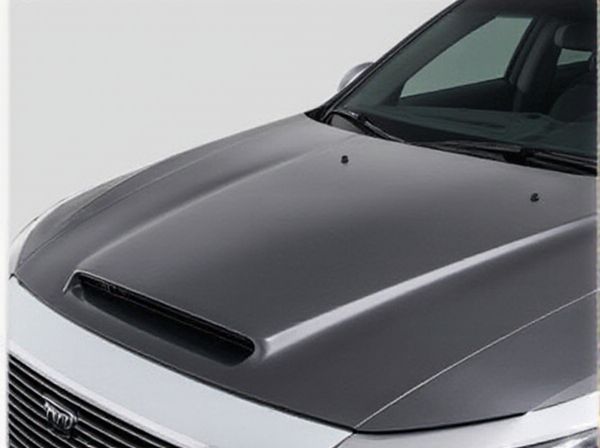
Photo illustration: Scoop Hood vs Flat Hood
A scoop hood enhances engine performance by directing cooler air into the intake, improving horsepower and fuel efficiency, whereas a flat hood offers a sleek, minimalist appearance with less emphasis on airflow. You'll find scoop hoods ideal for high-performance vehicles seeking better engine cooling, while flat hoods suit those prioritizing aesthetics and a clean, streamlined look. Choosing between them depends on balancing functional benefits with your vehicle's style preferences.
Table of Comparison
| Feature | Scoop Hood | Flat Hood |
|---|---|---|
| Design | Raised scoop enhancing airflow and engine cooling | Flat, smooth surface offering a clean and simple look |
| Performance | Improves air intake, boosts engine efficiency and power | Minimal impact on engine performance and airflow |
| Aerodynamics | May increase drag but improves cooling | Better aerodynamic profile, reducing drag |
| Installation | Requires modification or custom fitting | Easier to install, often stock or direct replacement |
| Cost | Generally higher due to complexity and materials | Lower cost, widely available |
| Use Case | Performance cars, racing, enhanced cooling needs | Daily drivers, classic look, minimal maintenance |
Scoop Hood vs Flat Hood: An Introduction
Scoop hoods enhance engine performance by directing cooler, denser air into the intake, improving combustion efficiency and power output in vehicles. Flat hoods offer a streamlined, minimalist design favored for their simplicity, reduced weight, and ease of maintenance, often chosen for aesthetic or aerodynamic reasons. Comparing scoop hood vs flat hood highlights the balance between functional airflow benefits and sleek, understated styling preferences in automotive design.
Key Design Differences
Scoop hoods feature raised sections with vents or openings designed to channel air directly into the engine compartment, enhancing cooling and performance, whereas flat hoods provide a smooth, level surface without airflow modifications. Scoop hoods typically create a more aggressive, sporty aesthetic, while flat hoods offer a cleaner, minimalist appearance. The functional airflow advantage of scoop hoods makes them popular in performance vehicles, contrasting with the aerodynamic simplicity favored in flat hood designs.
Performance Impacts: Aerodynamics and Engine Cooling
Scoop hoods improve engine cooling by directing airflow directly into the engine bay, enhancing heat dissipation and potentially boosting horsepower. Flat hoods offer better aerodynamics by maintaining a smooth airflow over the vehicle, reducing drag and improving fuel efficiency. Choosing between scoop and flat hoods depends on whether the priority lies in maximizing engine cooling or optimizing aerodynamic performance.
Visual Appeal and Aesthetics
Scoop hoods feature raised, vented sections that create a bold, aggressive look, enhancing the car's sporty and performance-oriented image. Flat hoods offer a clean, minimalist aesthetic that appeals to those seeking a sleek and understated appearance. The choice between scoop and flat hoods significantly influences a vehicle's visual personality, with scoop hoods emphasizing dynamic presence and flat hoods promoting simplicity and elegance.
Functional Benefits in Real-World Driving
Scoop hoods enhance engine cooling by directing more airflow into the engine bay, which improves performance during high-speed driving and intense conditions. Flat hoods offer better aerodynamic efficiency, reducing drag and contributing to improved fuel economy on highways. Both designs provide distinct advantages: scoop hoods prioritize engine temperature management, while flat hoods optimize streamlined driving dynamics.
Maintenance and Durability Considerations
Scoop hoods typically require more frequent cleaning and maintenance due to their exposed air intakes, which can accumulate dirt and debris affecting engine performance. Flat hoods offer easier upkeep with fewer crevices for contaminants to collect, making them more durable in harsh weather conditions and reducing long-term wear. Choosing between scoop and flat hoods depends on balancing the need for improved airflow with maintenance demands and durability requirements.
Cost Comparison: Installation and Upkeep
Scoop hoods generally incur higher installation costs due to their complex design and need for precise fitting to ensure optimal air intake and aesthetic appeal. Flat hoods, with simpler, streamlined shapes, tend to be more affordable to install and maintain, requiring less specialized labor and fewer materials. Maintenance expenses for scoop hoods are often elevated because of potential debris buildup and more intricate cleaning needs compared to the straightforward upkeep of flat hoods.
Compatibility with Different Vehicle Types
Scoop hoods offer enhanced airflow and a sporty appearance, making them ideal for performance vehicles and muscle cars, while flat hoods provide a sleek, minimalist look suited for trucks and classic cars. Compatibility depends on the vehicle's engine clearance and design, as scoop hoods require extra space for air intake systems. Flat hoods typically fit a wider range of vehicles due to their simpler shape and lower profile.
User Preference and Market Trends
User preference for scoop hoods often centers on aggressive styling and enhanced engine cooling, appealing to performance enthusiasts and sports car owners. Flat hoods attract buyers seeking a sleek, minimalist appearance and easier customization potential, favored in urban and commuter vehicle markets. Market trends indicate a growing demand for scoop hoods in muscle cars and aftermarket modifications, while the flat hood remains popular in electric and eco-friendly vehicles due to aerodynamic efficiency.
Conclusion: Choosing the Right Hood for Your Needs
Selecting between a scoop hood and a flat hood depends on your vehicle's performance goals and aesthetic preferences. Scoop hoods enhance engine cooling and airflow, ideal for high-performance cars seeking better intake efficiency. Flat hoods offer a sleek, minimalist look and are suitable for everyday driving where aerodynamic simplicity and ease of maintenance are priorities.
 caratoz.com
caratoz.com